|
Derek Fountain : Tyre Gauge Dissection
Programmer, Writer, Consultant, Dissector
|


|
|
|
|
|
|
|
|
|
|
|
|
|
|
|||

|
|||

|
|||

|
|||
I went to check the tyre pressures on the car and found the digital tyre pressure gauge battery was flat. I unscrewed it and found the battery was thoroughly glued in. You're obviously supposed to buy a new one instead of just replacing the battery. So I took it apart to find out how it worked.
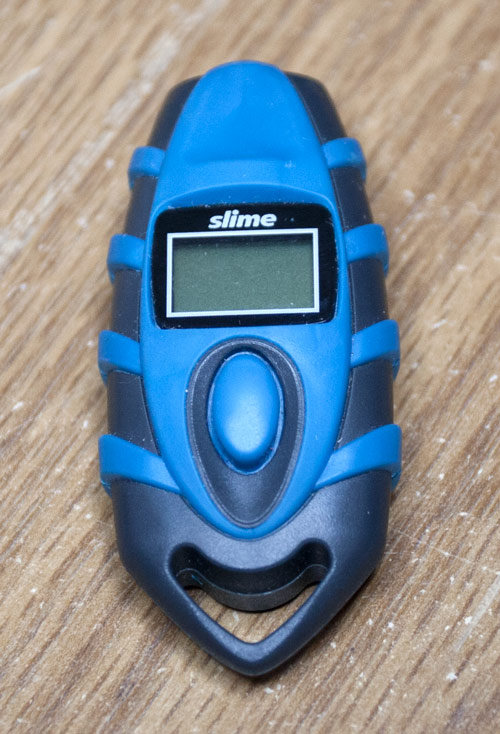
The gauge has a button on the front to turn it on and an LCD display which shows the reading, initially 0.0. You press it against the valve and up pops the number.
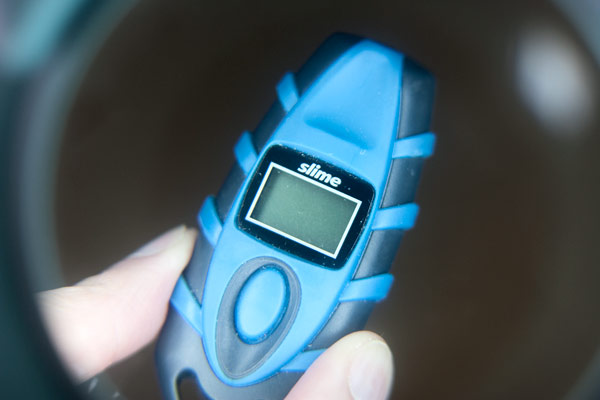
I took the front off which reveals the connection to the LCD display which is mounted into the front plastic part. It uses a bit of zebra strip, which is the typical solution for such LCD connections.
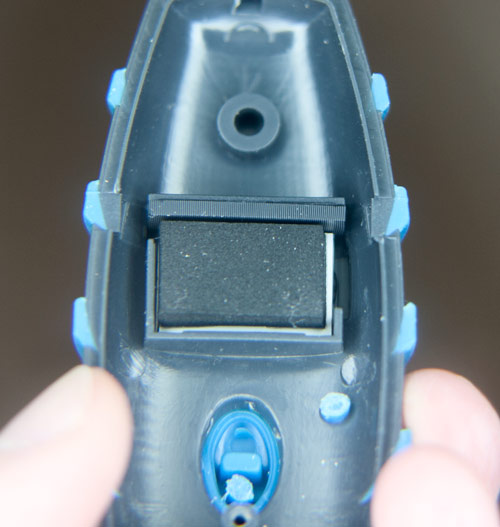
Here's the other side of the connector - the PCB. The row of connectors is where the zebra strip marries up, and the main switch is lower down:
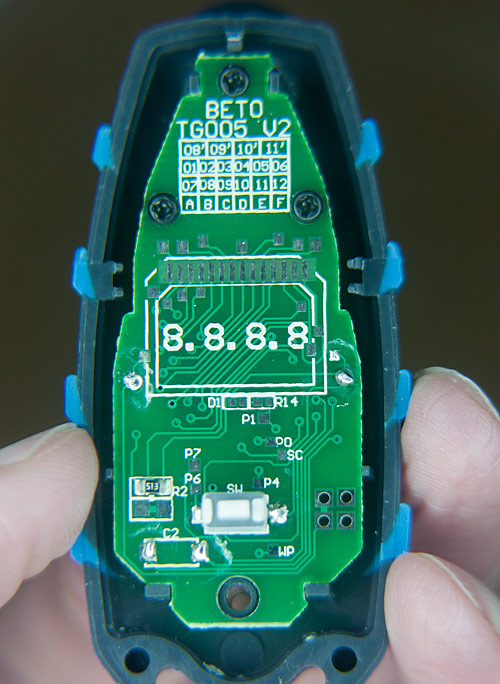
I took the PCB out. The more interesting stuff is on the other side:
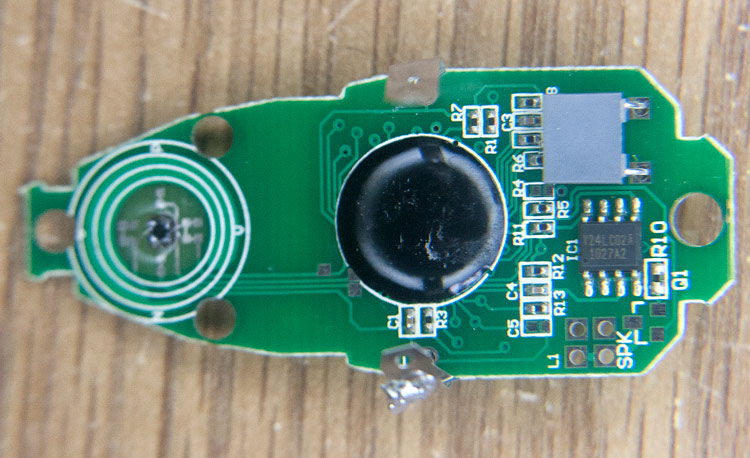
The circular structure is the pressure sensor (blurred in this image, but see below for a better look). There's a big blob of epoxy (or something) which covers the main circuitry of the device, and a small integrated circuit. There's a connector for a speaker, although my device didn't have one. There's various connection pads where, presumably, a test or calibration jig can connect up using pogo pins. You can't see it on the photos but some are marked where they've been used.
Here's a better shot of the sensor:
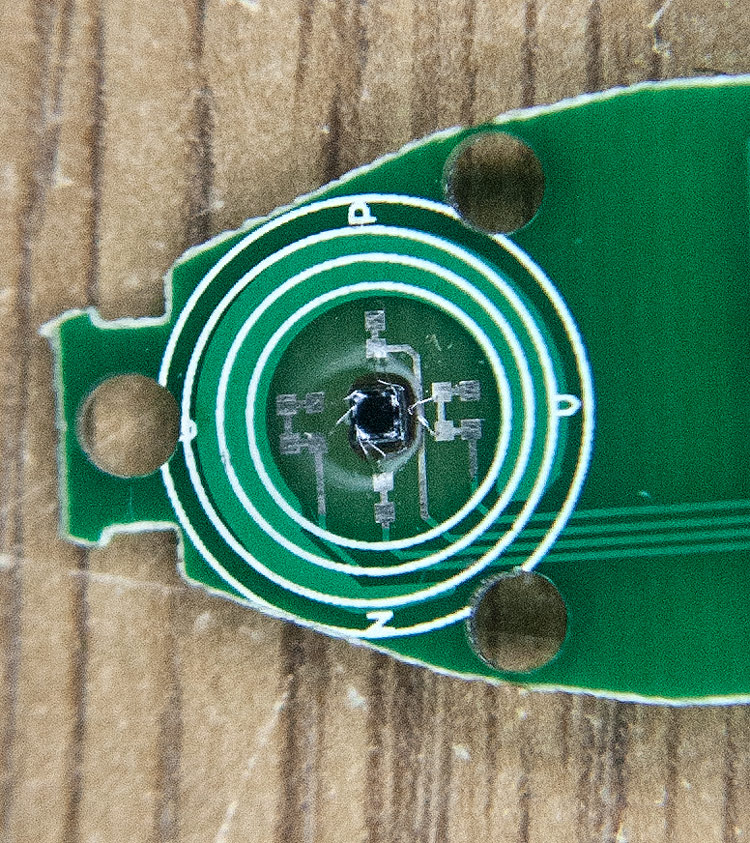
You can't tell from the photo but there's a big blob of soft, springy, translucent material covering what's inside the innermost concentric circle. The tyre value is lined up over that and the air from the tyre puffs against it, deforming it. The black thing in the middle is presumably some sort of strain gauge, which appears to be in the middle of what looks like a Wheatstone bridge. The output from the bridge goes along the tracks at bottom right to the main circuitry.
On the other side there's this 8 pin IC, labelled Y24LC02. A spot of Googling finds a data sheet for it. It's a 256 byte serial EEPROM.
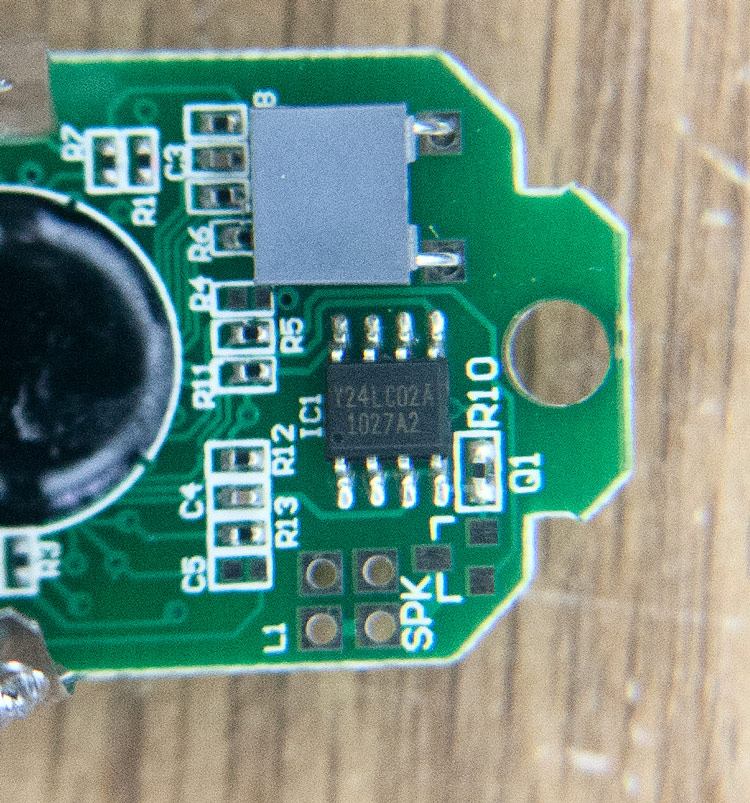
My assumption here is that during manufacturing the device is presented to a test jig which connects up using pogo pins. It blasts air onto the device's sensor and reads the output. Since it knows the pressure of the air delivered, and the output from the sensor, it can produce a bit of calibration data which describes the difference between the pressure which was delivered and what was actually read. That calibration data is written into the little EEPROM. That's used by the circuitry to adjust the reading from the car tyre, making it accurate despite the vagaries of the sensor and the production process. Since the EEPROM is a TWI device, the circuitry under that epoxy must implement a complete TWI bus.
I desoldered the EEPROM IC and connected it up to an Arduino to see what was stored in there:
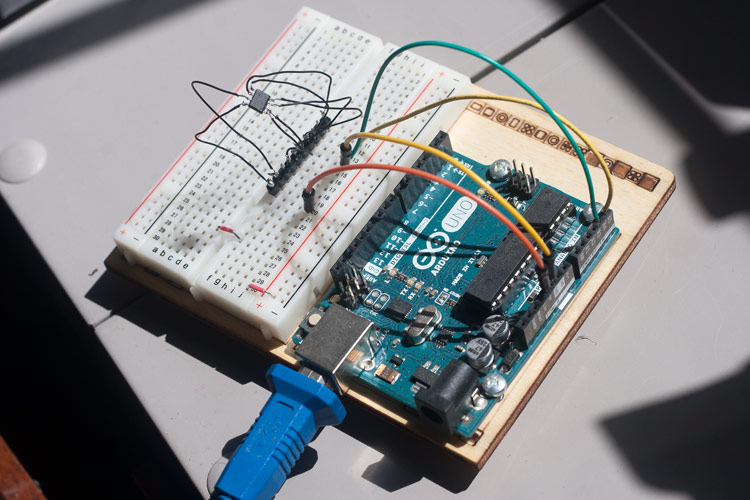
The answer is this:
0xFF 0xCA 0xC8 0x05 0x01 0x20 0x03 0x01 0x01 0x01 0x09 0xE6 0xC8 0x0B 0x02 0x23 0x28 0x32 0x0B 0x0F 0x10 0x14 0x0A 0x0F 0xFF 0xFF 0xFF 0xFF 0xFF 0xFF 0xFF 0xFF 0xFF 0xFF 0xFF 0xFF 0xFF 0xFF 0xFF 0xFF 0xFF 0xFF 0xFF 0xFF 0xFF 0xFF 0xFF 0xFF 0xFF 0xFF 0xFF 0xFF 0xFF 0xFF 0xFF 0xFF 0xFF 0xFF 0xFF 0xFF 0xFF 0xFF 0xFF 0xFF 0xFF 0xFF 0xFF 0xFF 0xFF 0xFF 0xFF 0xFF 0xFF 0xFF 0xFF 0xFF 0xFF 0xFF 0xFF 0xFF 0xFF 0xFF 0xFF 0xFF 0xFF 0xFF 0xFF 0xFF 0xFF 0xFF 0xFF 0xFF 0xFF 0xFF 0xFF 0xFF 0xFF 0xFF 0xFF 0xFF 0xFF 0xFF 0xFF 0xFF 0xFF 0xFF 0xFF 0xFF 0xFF 0xFF 0xFF 0xFF 0xFF 0xFF 0xFF 0xFF 0xFF 0xFF 0xFF 0xFF 0xFF 0xFF 0xFF 0xFF 0xFF 0xFF 0xFF 0xFF 0xFF 0xFF 0xFF 0xFF 0xFF 0xFF 0xFF 0xFF 0xFF 0xFF 0xFF 0xFF 0xFF 0xFF 0xFF 0xFF 0xFF 0xFF 0xFF 0xFF 0xFF 0xFF 0xFF 0xFF 0xFF 0xFF 0xFF 0xFF 0xFF 0xFF 0xFF 0xFF 0xFF 0xFF 0xFF 0xFF 0xFF 0xFF 0xFF 0xFF 0xFF 0xFF 0xFF 0xFF 0xFF 0xFF 0xFF 0xFF 0xFF 0xFF 0xFF 0xFF 0xFF 0xFF 0xFF 0xFF 0xFF 0xFF 0xFF 0xFF 0xFF 0xFF 0xFF 0xFF 0xFF 0xFF 0xFF 0xFF 0xFF 0xFF 0xFF 0xFF 0xFF 0xFF 0xFF 0xFF 0xFF 0xFF 0xFF 0xFF 0xFF 0xFF 0xFF 0xFF 0xFF 0xFF 0xFF 0xFF 0xFF 0xFF 0xFF 0xFF 0xFF 0xFF 0xFF 0xFF 0xFF 0xFF 0xFF 0xFF 0xFF 0xFF 0xFF 0xFF 0xFF 0xFF 0xFF 0xFF 0xFF 0xFF 0xFF 0xFF 0xFF 0xFF 0xFF 0xFF 0xFF 0xFF 0xFF 0xFF 0xFF 0xFF 0xFF 0xFF 0xFF 0xFF 0xFF 0x00
Some numbers! Most of the EEPROM is unused. I was a bit disappointed to be honest. I was hoping for a version number or a copyright message or something. Oh well.
So that was quite an interesting dissection of a dull little device. But given the mess I'd made of it I threw it away and bought a new one.
Site and content Copyright 2023 Derek Fountain - All Rights Reserved
